Setup Saturday: Gun Belts and Holsters
To carry a gun you need quality gun belts and holsters designed to support the weight of a firearm. They work together as the foundation for a secure comfortable carry.
Continue ReadingTo carry a gun you need quality gun belts and holsters designed to support the weight of a firearm. They work together as the foundation for a secure comfortable carry.
Continue Reading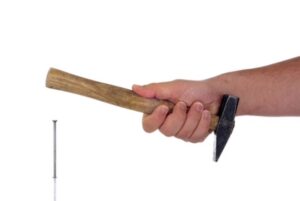 Tuesday is here and it is time for another Tuesday training tip. Last week we talked about stance, and how it is the foundation that we build everything else on. Today we talk about proper pistol grip and how having proper grip is one of the most important factors in not only hitting your target, but being safe as well.
Tuesday is here and it is time for another Tuesday training tip. Last week we talked about stance, and how it is the foundation that we build everything else on. Today we talk about proper pistol grip and how having proper grip is one of the most important factors in not only hitting your target, but being safe as well.
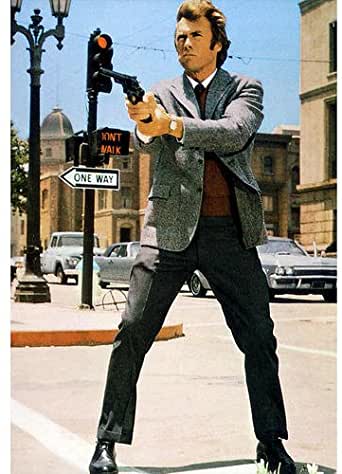 We have all seen the movies and T.V. shows where the good guy is searching for the bad guy and he is holding his pistol kind of like we see here. The problem with this is that if he actually shot the gun the way he is holding it there is a really good chance that.
We have all seen the movies and T.V. shows where the good guy is searching for the bad guy and he is holding his pistol kind of like we see here. The problem with this is that if he actually shot the gun the way he is holding it there is a really good chance that.
There are so many wrong ways to hold a gun that if I tried to show them all to you, you would be here for the next year reading, but I wanted to show one of the most well know wrong ways.
The proper pistol grip is about controlling the pistol. It allows you to manage recoil, deliver your round on target, get and keep your sights on your target, and in a self-defense situation keep your pistol in your possession. so lets get into how to form the proper grip.
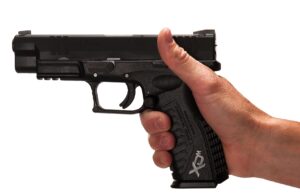
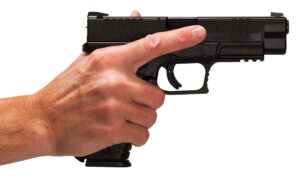 When setting up your grip, the pistol should be placed firmly into your firing hand like you are making a fist, with the web of your hand high and centered on the back strap. The firing hand thumb should be high, to create a space for the support hand. Your index finger needs to be OUTSIDE THE TRIGGER GUARD and placed high up on the frame of the pistol.
When setting up your grip, the pistol should be placed firmly into your firing hand like you are making a fist, with the web of your hand high and centered on the back strap. The firing hand thumb should be high, to create a space for the support hand. Your index finger needs to be OUTSIDE THE TRIGGER GUARD and placed high up on the frame of the pistol.
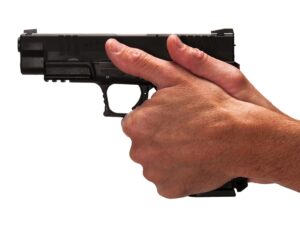 The fingers of your support hand wrap firmly around the firing hand with the index finger pressed firmly against the bottom of the trigger guard and the meaty part of your support hand nestled into the open space on the grip left by the firing hand. Your thumbs should be “stacked” firing hand thumb over support hand thumb.
The fingers of your support hand wrap firmly around the firing hand with the index finger pressed firmly against the bottom of the trigger guard and the meaty part of your support hand nestled into the open space on the grip left by the firing hand. Your thumbs should be “stacked” firing hand thumb over support hand thumb.
When you look at your grip you should not see any “space” between your palm and the grip of the pistol. We want to make sure that we have total contact between our hands and the pistol. A mantra that my mentor drills into us is “the more of the gun you can touch, the more of the gun you can control”
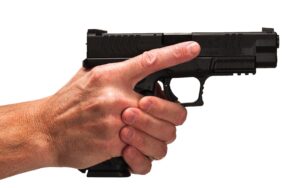 Now lets talk about grip pressure, or how tight you grip with each hand. I will tell you now, i don’t know and the truth is I don’t care. If you do a search for this topic you will find that EVERYONE has their opinion and everyone THINKS they are right. You will see 50/50, 60% support hand 40% firing hand, 70/30, 80/20, whatever! They are all wrong, yet…they are all right as well. The fact is that it is going to be different for every single person out there, and the only way to know is to get out there and find an instructor, train and shoot. I can tell you that for me it is about 75/25. Once again though you will be different.
Now lets talk about grip pressure, or how tight you grip with each hand. I will tell you now, i don’t know and the truth is I don’t care. If you do a search for this topic you will find that EVERYONE has their opinion and everyone THINKS they are right. You will see 50/50, 60% support hand 40% firing hand, 70/30, 80/20, whatever! They are all wrong, yet…they are all right as well. The fact is that it is going to be different for every single person out there, and the only way to know is to get out there and find an instructor, train and shoot. I can tell you that for me it is about 75/25. Once again though you will be different.
If you hold a hammer with two fingers you way still be able to drive that nail, but it isn’t going to be nearly as easy to control, or even as close to as effective as it could be. The same goes for the grip on your firearm. develop a proper grip and you will be safe and a far more effective shooter.

Evil criminal in a mask looking at the viewer; copy space on the left.
Monday again…yay…right? right? Mindset is one of the things I have always found most useful when thinking and learning about fighting. So now I get to think about it every Monday, and it makes me happy. I know last week I talked about awareness and the first main type of violence, social violence. Well this is the second part to that. Asocial Violence.
Asocial violence is the really scary stuff. This is where the real injury and great bodily harm happen. While social violence is the world of the chest beaters and hot heads (neither of which we should be if we are training to carry and use a weapon), Asocial violence it where the murderers, rapists, kidnappers live. The three percent of the population that can be called socio/psychopath.
There is no social game being played, this isn’t a monkey dance, this is predator and prey. You are the means to to an end, food to be devoured. I like to show students videos of what I mean. Below is one of my favorite videos to illustrate asocial violence. this happened late last year (2020) and while it is not graphic, it perfectly shows what asocial violence is. (It is loud)
There are two main types of human predators.
What type of predator was shown in the video above?
 The most effective thing that you can do to keep from encountering this type of violence is to avoid putting yourself in situations where you may run into these types of predators and be aware of your surroundings so that you can spot this danger before it becomes a real threat. when you are out in public,
The most effective thing that you can do to keep from encountering this type of violence is to avoid putting yourself in situations where you may run into these types of predators and be aware of your surroundings so that you can spot this danger before it becomes a real threat. when you are out in public,
Even doing everything you can to not get into a situation, if someone is motivated enough…the situation may find you. It is these times that we train and prepare for and, where the other 2 areas of mindset come in…but those are other posts. Make sure to stay up to date with us, like our Facebook page and share our articles

When I first started figuring out the types of posts that I wanted to do weekly, an equipment series was defiantly one of the first that came to mind. One of the biggest things that new shooters deal with when they first start training is what equipment they need. It can be completely overwhelming looking at a 24 foot wall of handguns, or holsters, or whatever. The choice and variety is both a blessing and a curse of the industry. I figured who better to help me with this than the person that has helped guide me through the maze of available gear. Thankfully he agreed so I would like to introduce you to one of my friends, and one of the best shooters that I have the pleasure of knowing, Travis Glinski.
Every week he will cover the essential gear that every shooter should have. From every day carry (EDC) to advanced training Travis has the knowledge and experience to help us all make sense of all He has decided that he would like to call this series “Building the Modern Minute Man”.the options. Enjoy this first installment below.
Gear, we love it, we crave it, we flex on instagram with it, but are you buying the right gear for you? Or are you buying it because your favorite online operator is being paid to sell it to you? It is easy to get deep in the weeds on gear and they only get thicker the further down you go. So why not start at the top and cover the absolute basics for everyone, beginner or seasoned this should be the bare minimum for the prepared individual.
Before we get into gear, there is a disclaimer. No amount of widgets, gadgets, optics, or money can ever buy you skill. That is earned under the watchful eye of a competent instructor. If you are new, that’s fine, this will get you the basic equipment needed to get started. However, after you’re started, instead of buying another wackmaster 4000 or phased plasma rifle in the 40 watt range, go get training to use what you have.
With my infomercial done we can truly begin. I figured we could start at what seems most logical, the gun. I mean, that’s why we all got here, right? Hopefully this will not only provide you with what to get but why to get it, I always feel that understanding why a purchase is being made can help me wrestle with the age old quantity vs quality problem. Buy the right thing and buy it once, do that and I promise you, I will have saved you so much wasted money.
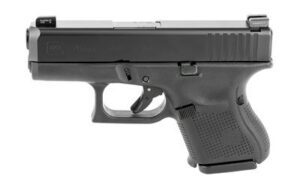 So, where were we? Ah, yes, blasters. Its funny because when I started getting into guns there were like six options, now, you can get a single stacked pocket glock, or a modular sig p320 and anything in between. It is a blessing and a curse. The good news is new gun owners have so many options to find the right gun, the downside is there are SO many options, how could we possibly ever narrow it down? Easy, for absolutely everyone I recommend any companies version of the glock 19, everyone makes one. Whether its the sig 320, m&p 2.0c, canik tp9 sf elite, walther pdp, hk vp9, cz p10c, it doesn’t matter, just get that companies version of the glock 19.
So, where were we? Ah, yes, blasters. Its funny because when I started getting into guns there were like six options, now, you can get a single stacked pocket glock, or a modular sig p320 and anything in between. It is a blessing and a curse. The good news is new gun owners have so many options to find the right gun, the downside is there are SO many options, how could we possibly ever narrow it down? Easy, for absolutely everyone I recommend any companies version of the glock 19, everyone makes one. Whether its the sig 320, m&p 2.0c, canik tp9 sf elite, walther pdp, hk vp9, cz p10c, it doesn’t matter, just get that companies version of the glock 19.
They typically have a 4 to a 4.5 inch barrel, striker fired, polymer frame, and a magazine that holds 15 rounds and its chambered in 9mm. It is the perfect sized gun, it is small enough to carry but big enough to fight with. Of course, Im going to suggest you just get the original, the og, the one and only Glock 19.
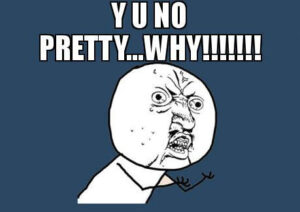 Most people will buy everything before they buy a Glock, “its ugly”, “I don’t like Glocks”, “Glocks are plastic junk”, Ive heard it all and its all nonsense and excuses.
Most people will buy everything before they buy a Glock, “its ugly”, “I don’t like Glocks”, “Glocks are plastic junk”, Ive heard it all and its all nonsense and excuses.
All the guns Ive listed are competitively priced so they all win there, what aren’t competitively priced are magazines, sig costs $50, cz is about $30-$40, s&w is in the $35 range, but glocks, $15 on sale $20 normally. Any company that makes a holster makes it for a glock 19, need a spare part because you dropped it, or lost it? They’re everywhere and they’re cheap. The cost of ownership is the lowest with a glock 19 and if after 40 years people are still trying to beat it, its a logical place to start.
~Travis Glinski~
Hopefully this post will help you if you are just starting out as a shooter or even have some experience but looking to add to your gear. Having the right equipment is the first step.
Tuesday is here and it’s time to begin “training tip Tuesday”. This is where we are going to talk about training tips and techniques. We are going to start with the fundamentals of; stance, grip, sight picture, trigger control, and follow through. Today’s post will focus on shooting stance and why it is so important.
What do building a house, baking a layer cake, and shooting all have in common? to be successful they all require a solid foundation. In a house it is brick, cinder block, or cement. The first layer of a cake needs to be the most level or the cake will fall. In shooting it all starts with what touches the ground…for most of us, that’s our feet.
If you ask 100 firearms instructors what the best shooting stance is, you will get several different answers. The truth is that none of them are wrong. It really depends on several different factors but, there are 3 “main” shooting stances.
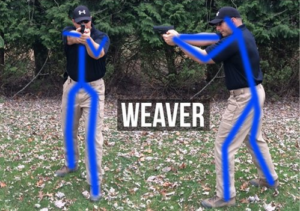 The first is the Weaver stance. this stance was developed in the late 1950’s by competition shooter and L.A. county deputy, Jack Weaver. There are a couple different tales on how this stance developed but, the short versions are that it was either that he was competing in quick draw competitions and wanted a way to draw and use sighted fire as quickly as possible. The other is that there was a match coming up and he had an injury that prevented him from fully extending his support (or non firing) arm. Either way because of his success in matches this became the “standard” shooting platform for civilians, and law enforcement alike. This stance is characterized by the following.
The first is the Weaver stance. this stance was developed in the late 1950’s by competition shooter and L.A. county deputy, Jack Weaver. There are a couple different tales on how this stance developed but, the short versions are that it was either that he was competing in quick draw competitions and wanted a way to draw and use sighted fire as quickly as possible. The other is that there was a match coming up and he had an injury that prevented him from fully extending his support (or non firing) arm. Either way because of his success in matches this became the “standard” shooting platform for civilians, and law enforcement alike. This stance is characterized by the following.
Pros: This allows the shooter to use a very stable “push/pull” grip where the firing arm pushes and the support arm pulls, making it easier to manage recoil. This is a great “marksman” style stance and is very stable.
Cons: The biggest cons to me are that in the L.E. sector this stance can expose part of your body (side) that is unprotected. In the civilian world this stance can be difficult to maintain in a dynamic, defensive situation.
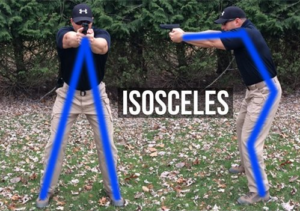 The next stance is the isosceles stance. This stance is the most commonly taught to new shooters. This is because many argue that it mimics the body’s natural reaction posture that will happen in a defensive situation. Like the Weaver stance this stance became popular when in the 1980’s Brian Enos, and Rob Leatham began using it to win IPSC shooting competitions. This stance is formed by.
The next stance is the isosceles stance. This stance is the most commonly taught to new shooters. This is because many argue that it mimics the body’s natural reaction posture that will happen in a defensive situation. Like the Weaver stance this stance became popular when in the 1980’s Brian Enos, and Rob Leatham began using it to win IPSC shooting competitions. This stance is formed by.
Pros: The major positives to this stance are that it feels like a very natural stance to most people, because of the fully extended arms it allows for greater recoil management. This has a positive effect on accuracy when delivering multiple shots.
Cons: While this stance is very stable side to side, it is unstable forward to back. This stance also does not allow the shooter to be as agile during movement.
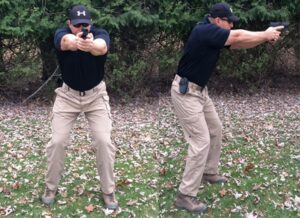 This final stance can be called by many names; fighting, boxer, tactical, modified isosceles, etc. I call it a “fighting” stance and it is the one that I use and teach in my Concealed Carry and Home Defense Fundamentals and my Basic Pistol courses because, I believe that it strikes the right balance of natural feeling, stability, and ease of movement. It was developed in the military/special forces and has made its way into civilian defensive shooting. This stance is similar to the isosceles.
This final stance can be called by many names; fighting, boxer, tactical, modified isosceles, etc. I call it a “fighting” stance and it is the one that I use and teach in my Concealed Carry and Home Defense Fundamentals and my Basic Pistol courses because, I believe that it strikes the right balance of natural feeling, stability, and ease of movement. It was developed in the military/special forces and has made its way into civilian defensive shooting. This stance is similar to the isosceles.
Pros: This stance works for any weapon system; handgun, rifle, knife, baton, etc. so you only need to train one stance. This stance provides stability both side to side and front to back. It also makes it easy to move in any direction, allowing you to stay more dynamic.
Cons: There really aren’t any. By modifying the isosceles to be more stable it eliminates the main drawback of the isosceles. If I had to give a con it is that it can sometimes be harder for people with mobility problems to get into properly.
Like I said before, everyone has the stance that they prefer, and they all have pros and cons. find the one that works best for you and the type of training that you are doing.
 It’s Monday again! A little while back I wrote about the three things that I feel make up a “protector” mindset; awareness, confidence, and purpose. Well it is time to start expanding on those three topics. Today we look at part of what makes up awareness, How to recognize “social” violence. When you are confronted with a possibly violent situation, it is important to be able to recognize the type of violence that you are seeing or may need to deal with.
It’s Monday again! A little while back I wrote about the three things that I feel make up a “protector” mindset; awareness, confidence, and purpose. Well it is time to start expanding on those three topics. Today we look at part of what makes up awareness, How to recognize “social” violence. When you are confronted with a possibly violent situation, it is important to be able to recognize the type of violence that you are seeing or may need to deal with.
Imagine with me if you will, you are out at a bar with your friends. You and your buddy walk towards the bar to get another round and your friend accidentally bumps into a guy with his friends. He turns and tells your friend “watch it a**hole”, well your friend (having had a couple glasses of liquid courage) responds with an equally “witty” comment. What happens next?
If you are a male born in the last 10,000 years or so you can probably see the event unfold like you are watching a rerun of your favorite T.V. show. If you happen to be a time traveling caveman or a toll bridge troll reading this lets walk through it really quick.
insult, insult, someone throws their arms out and says “what are you gonna do about it”, they get nose to nose, another couple insults, one pushes the other, big haymaker punch, a few quick blows, someone on the ground with a bloody nose or busted lip, friends pull the two apart.
Why is it that we all saw this before I said it? It’s really pretty easy to understand. Humans at our basic level are just animals, and as animals we have a social hierarchy that we are always trying to find our place in. What we just described is an example of “social” violence. This is the typical type of violence that we see in high schools, bars, etc. There are a few tell tail signs that you can watch out for that are dead giveaways that you are dealing with social violence.
The common thing that drives social violence is ego, We as humans want and need our peers to respect us and, we need to respect ourselves. Unfortunately for too many people this does not manifest as self-confidence but, as an inflated and fragile ego. As such, we allow any threat to our egos to control our actions and most times make poor decisions. If we carry a weapon for self defense these ego driven decisions can lead to far worse than a bloody nose. It can lead to criminal charges, jail, or if things escalate farther, the loss of life either our own or someone else.
By being aware of and letting go of our own ego we can avoid or defuse almost all instances of social violence. When confronted with these situations it can be as simple as telling the other person that they win and walking away, Yes of course there will probably be some more insults but, they are just words and as the old school rhyme goes “sticks and stones may break my bones, but words will never hurt me”
If you would like to learn more you can register for our “Situational Awareness and Protector Mindset” course where we go far more in depth into the different types, causes, avoidance strategies, and how to respond to social violence. Learn More
Recent Comments